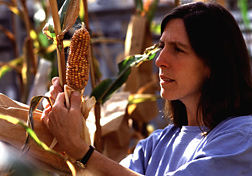Science Update
Let Us Eat Tastier Rice Cake
From 1992 to 1995, supermarket sales of rice cakes, a healthful, fat-free snack, rose from $157 million to nearly $249 million. Improving their flavor could win even more fans. Often, manufacturers simply put a coating of cheese or other flavor on the cake's surface. While this works well for thin, mini-size rice cakes, it doesn't always provide uniform flavor in the thicker, standard-size product. To boost taste appeal, ARS scientists and a manufacturer of organic rice products are devising a process for evenly spreading the added flavors. The work is being done under a cooperative research and development agreement (CRADA) between ARS and Wehah Farm, Inc., of Richvale, California.
William J. Orts, USDA-ARS Western Regional Research Center, Albany, California, phone (510) 559-5730.
Silenced, Corn Genes May Speak
|
|
In the corn plant, genes orchestrate flowering and other events that yield an earful of fat, nutritious kernels. To learn what part a given gene plays—by silencing it—ARS scientists have begun a new project. They are joining with colleagues at Pioneer Hi-Bred International, Inc., of Johnston, Iowa. Under a CRADA, scientists hope to discover functions of certain corn genes. These are genes recently found by researchers in California who are with ARS and the University of California. Their studies already reveal that one of the genes tells a corn plant how many flowers to make. It may prove possible to restructure some of the genes to boost yields or enhance tomorrow’s plants in other ways. The ARS and UC scientists are using Pioneer Hi-Bred’s “Trait Utility System for Corn” to reveal what jobs the newly discovered genes perform. TUSC relies on a strategy called loss-of-function. Through it, a selected gene can be turned off in experimental plants.
Sarah C. Hake, USDA-ARS University of California at Berkeley Plant Gene Expression Center, 800 Buchanan St., Albany, California, phone (510) 559-5907.
Prettier Pea Soup
Split pea soups could be a deeper green or a brighter yellow in a few years. And farmers will benefit from larger pea size and better disease resistance from three new varieties of dry peas. An ARS researcher developed and released the new varieties in cooperation with Washington State University and the University of Idaho. Joel, a green dry pea, resists powdery mildew and has greater yields and larger seeds than popular varieties now grown. It also keeps its dark green color after cooking. Fallon and Shawnee are yellow dry peas. They have higher yields, larger seeds, and better color than the industry standards. Fallon is semi-dwarf and semi-leafless. The traits help plants stand upright instead of falling over from wind or rain. The semi-leafless trait improves air circulation, reducing dampness that favors some diseases. Washington and Idaho produce most of the nation’s dry pea crop. About two-thirds is exported to Europe and Central and South America. For seed, growers can contact the Washington and Idaho state crop improvement associations. Fallon and Shawnee should be available for the 1998 growing season and Joel in 1999.
Frederick J. Muehlbauer, USDA-ARS Grain Legume Genetics and Physiology Research Unit, Pullman, Washington, phone (509) 335-9521.
Elk Unaffected by Pine Toxin
Pregnant elk that eat Ponderosa pine needles develop no reproductive problems. This discovery by ARS scientists could lead to ways to protect pregnant cattle. University of Iowa and Iowa State University researchers collaborated in the study. Ponderosa pines are common on grazing lands in the West. Scientists and ranchers already knew the needles can be toxic if eaten by pregnant cattle in the last trimester. Blood flow to the uterus declines, the cow delivers early, and calves often die. By the most recent estimate available, 1988, the problem costs cattle ranchers some $20 million annually. ARS scientists are testing several ruminants including bison, sheep, and goats to find ways to prevent so-called “pine needle abortions” in cattle. The scientists believe the toxins are made harmless by natural microorganisms in the elk’s rumen (the first of the four stomach compartments in a ruminant mammal). Now they are trying to determine differences between the natural microbial populations of the elk and cow rumen. In related studies, the university-ARS team discovered and patented potentially useful chemicals, waxy lipids, in Ponderosa pine needles. The lipids may have potential for treating postpartum hemorrhages and other ailments in people.
USDA-ARS Fort Keogh Livestock and Range Research Laboratory, Miles City, Mont.







